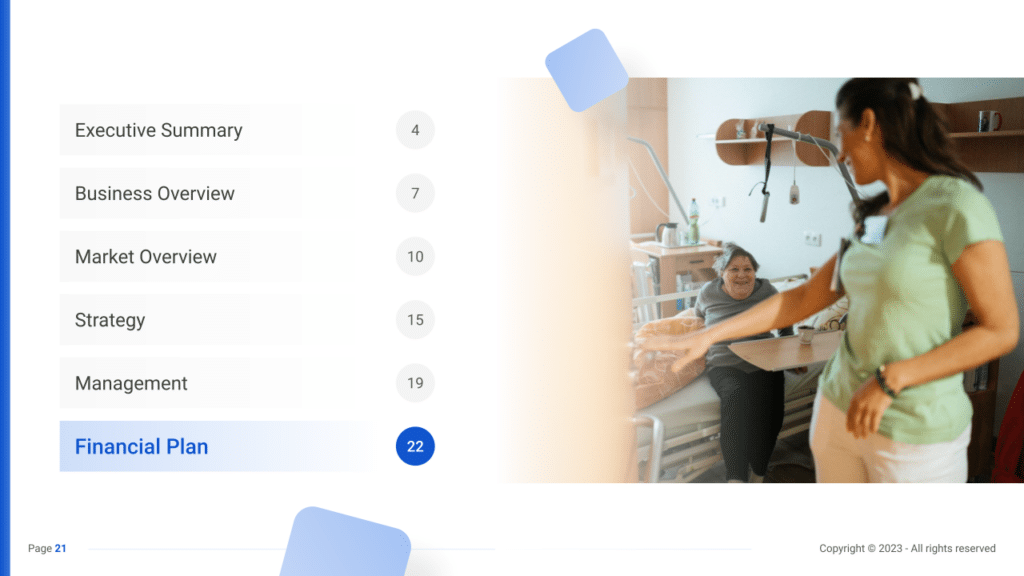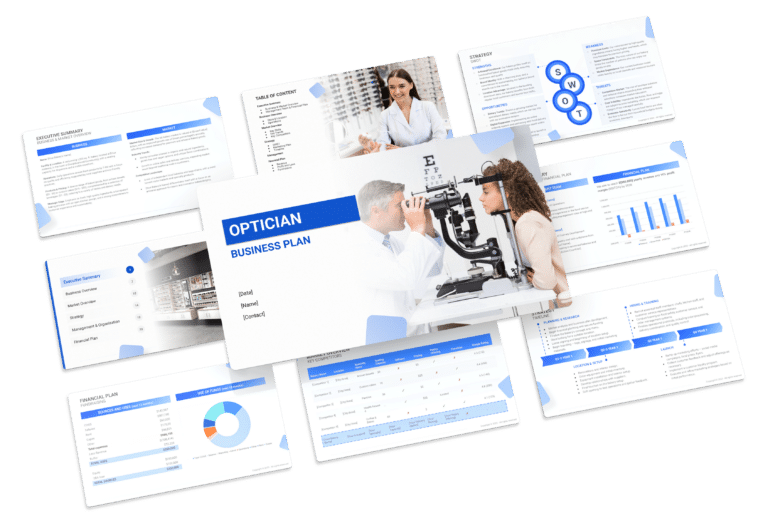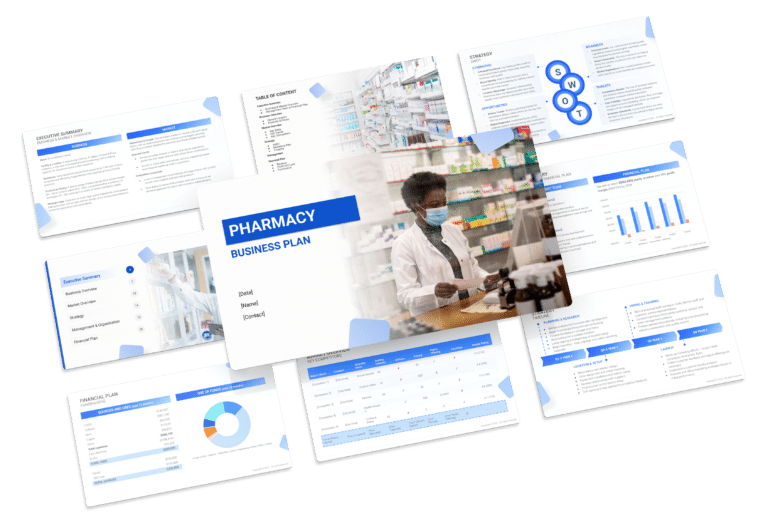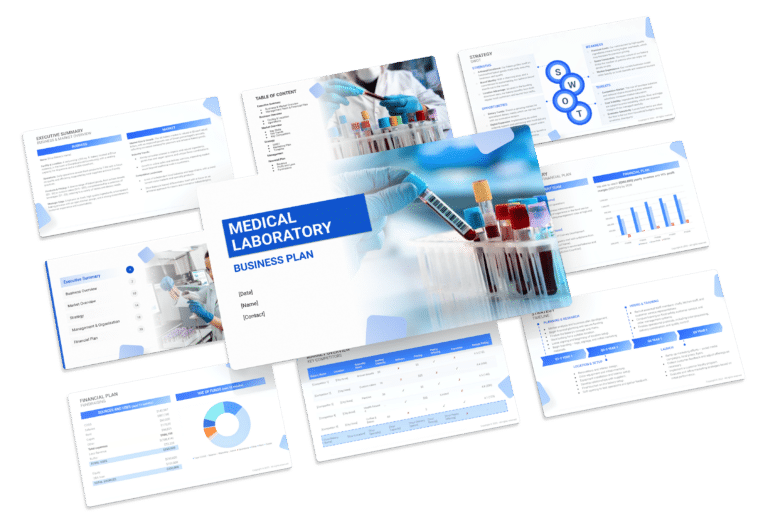Nursing Home Business Plan Template & PDF Example

Creating a comprehensive business plan is crucial for launching and running a successful nursing home. This plan serves as your roadmap, detailing your vision, operational strategies, and financial plan. It helps establish your nursing home’s identity, navigate the competitive market, and secure funding for growth.
This article not only breaks down the critical components of a nursing home business plan, but also provides an example of a business plan to help you craft your own.
Whether you’re an experienced entrepreneur or new to the healthcare industry, this guide, complete with a business plan example, lays the groundwork for turning your nursing home concept into reality. Let’s dive in!
The Plan
Our nursing home business plan is crafted to include all vital elements necessary for a detailed strategy. It outlines the home’s operations, marketing tactics, market dynamics, competitors, management team, and financial outlook.
- Executive Summary: Offers an overview of the Nursing Home’s business concept, highlighting its commitment to providing comprehensive care for the elderly, market analysis underscoring the growing demand for eldercare services, a skilled management team, and a financial strategy aimed at ensuring sustainability and growth.
- Business Overview: Provides detailed information on the services offered by the Nursing Home and its operational model:
- Facility & Location: Describes the Nursing Home’s design, amenities for resident comfort and well-being, and the strategic location chosen for accessibility and its appeal to potential residents and their families.
- Rooms, Medical Care & Recreational Activities: Lists the variety of accommodations and medical care services available, along with recreational activities designed to enrich the lives of residents.
- Market Overview: Examines the eldercare industry landscape, identifying key competitors and differentiating factors of the Nursing Home:
- Key Stats: Discusses the industry’s size, growth trends, and the significant demand for nursing home facilities, emphasizing the aging population and their care needs.
- Key Trends: Highlights the technological advancements in eldercare, shifts towards personalized care plans, and the importance of holistic wellness programs.
- Key Competitors: Analyzes the main competitors in the vicinity, noting how the Nursing Home distinguishes itself through its comprehensive care approach, modern facilities, and focus on creating a vibrant community for residents.
- Strategy: Outlines the Nursing Home’s strategic approach to growth and resident attraction:
- SWOT: A detailed Strengths, Weaknesses, Opportunities, and Threats analysis, tailored to the Nursing Home’s context, to inform strategic planning.
- Marketing Plan: A comprehensive strategy for promoting the Nursing Home’s services, including community outreach, partnerships with healthcare providers, and engagement strategies to build trust and reputation.
- Timeline: Sets key milestones and objectives from the planning stage through the first year of operation, including facility construction, staff recruitment, and service launch.
- Management: Provides information on the Nursing Home’s management team, detailing the roles, qualifications, and expertise of key personnel, emphasizing their ability to lead the facility toward achieving its care and service goals.
- Financial Plan: Projects the Nursing Home’s 5-year financial performance, including detailed forecasts of revenue from accommodation and care services, projected expenses, and profitability analysis to demonstrate the facility’s potential for financial success and operational sustainability.
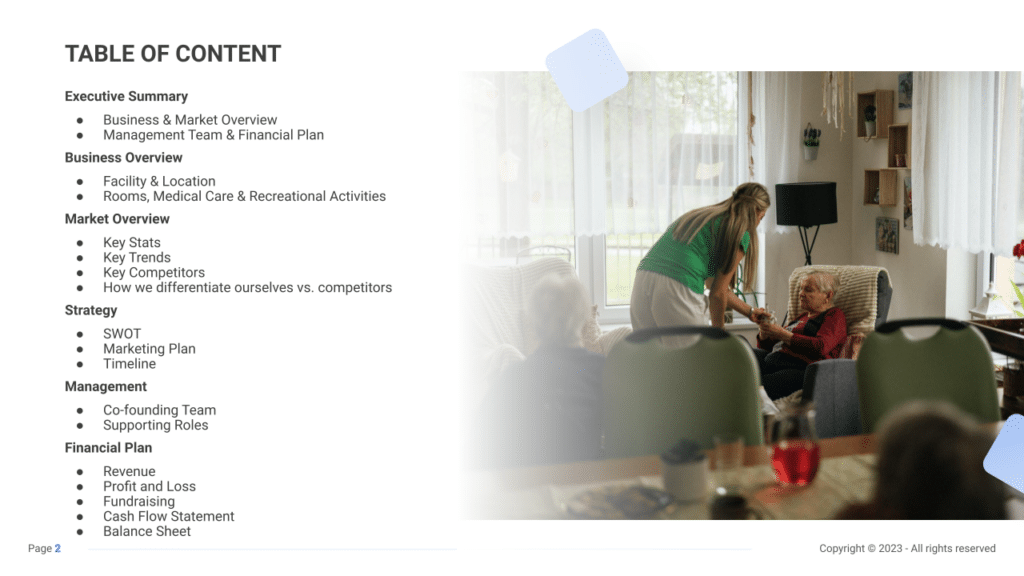
Executive Summary
The Executive Summary introduces your nursing home’s business plan, offering a concise overview of your facility and its services. It should detail your market positioning, the range of care and support services you offer, its location, size, and an outline of day-to-day operations.
This section should also explore how your nursing home will integrate into the local community, including the number of direct competitors within the area, identifying who they are, along with your nursing home’s unique selling points that differentiate it from these competitors.
Furthermore, you should include information about the management and co-founding team, detailing their roles and contributions to the nursing home’s success. Additionally, a summary of your financial projections, including revenue and profits over the next five years, should be presented here to provide a clear picture of your nursing home’s financial plan.
Nursing Home Business Plan Executive Summary Example

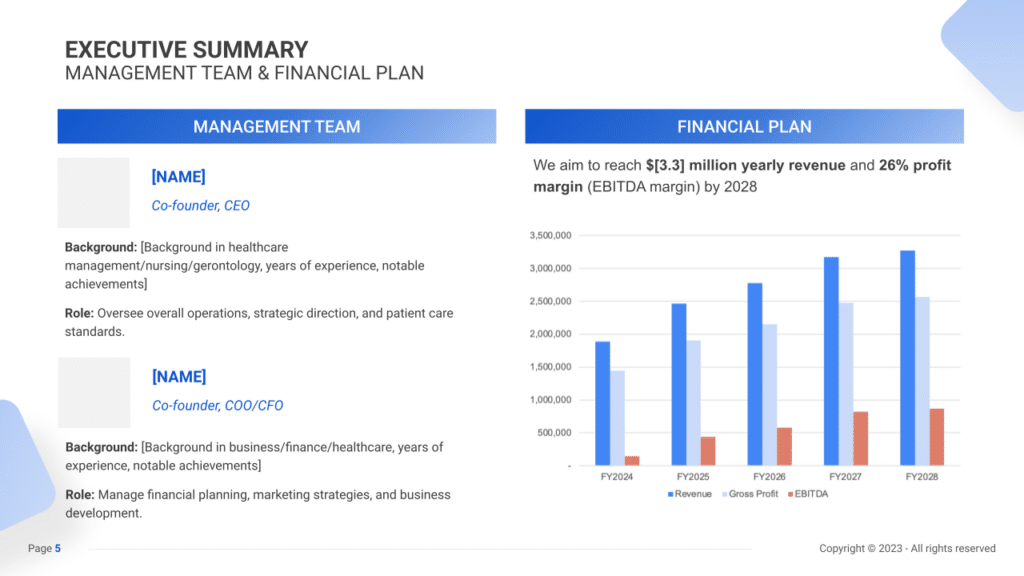
Business Overview
The business overview should clearly define the characteristics of the nursing home, such as the name, facility size, room options, care services, and recreational activities available. This part of the summary is crucial to showcase what sets your nursing home apart in the elder care market.
Example:
“Heartfelt Care Home,” spanning 20,000 square feet, offers a warm and spacious environment for its residents. With diverse room options and 24/7 comprehensive medical and personal care, it caters to a variety of needs. The facility, located in a serene area of Springfield, also provides a range of social and wellness activities, enhancing the residents’ quality of life.
Market Overview
This section should analyze the nursing home industry’s market size, growth trends, and competitive landscape. It positions your nursing home within the industry and highlights its potential to meet the increasing demand for elder care services.
Example:
Heartfelt Care Home enters a market valued at $185 billion, growing steadily due to an aging population. Despite seven competitors within the vicinity, the home differentiates itself with its premium care services and engaging community activities, addressing the needs of the growing senior demographic.
Management Team
Detailing the management team’s experience and roles is crucial. This part of the summary should emphasize their expertise in healthcare management and their roles in ensuring the nursing home’s operational excellence and high standard of care.
Example:
The CEO, with a background in healthcare management and gerontology, leads Heartfelt Care Home with a focus on excellent patient care standards. The COO/CFO, with experience in business and finance, manages the financial planning, marketing strategies, and business development, ensuring the home’s growth and profitability.
Financial Plan
A clear presentation of financial goals and projections is vital. This section should include revenue targets and profit margins, providing insight into the nursing home’s financial health and growth potential.
Example:
Heartfelt Care Home aims for $3.3 million in annual revenue with a 26% profit margin by 2028. With strategic financial planning and a commitment to quality care, the home is positioned for success in a robust and growing elder care market.
Business Overview
For a nursing home, the Business Overview section can be concisely divided into 2 main slides:
Facility & Location
Briefly describe the nursing home’s physical environment, emphasizing its design, safety, comfort, and the overall atmosphere that welcomes residents and their families.
Mention the nursing home’s location, highlighting its accessibility and the convenience it offers to residents and their visitors, such as proximity to medical facilities or ease of access for family visits. Explain why this location is advantageous in providing a serene and supportive environment for your target residents.
Rooms, Medical Care & Recreational Activities
Detail the range of care and support services offered, from basic assistance with daily activities to specialized medical and therapeutic services like rehabilitation, dementia care, or palliative support.
Outline your pricing strategy, ensuring it reflects the quality of care provided and matches the needs of the market you’re targeting. Highlight any inclusive services, membership deals, or programs that provide added value to your residents, promoting long-term stays and enhancing resident and family satisfaction.

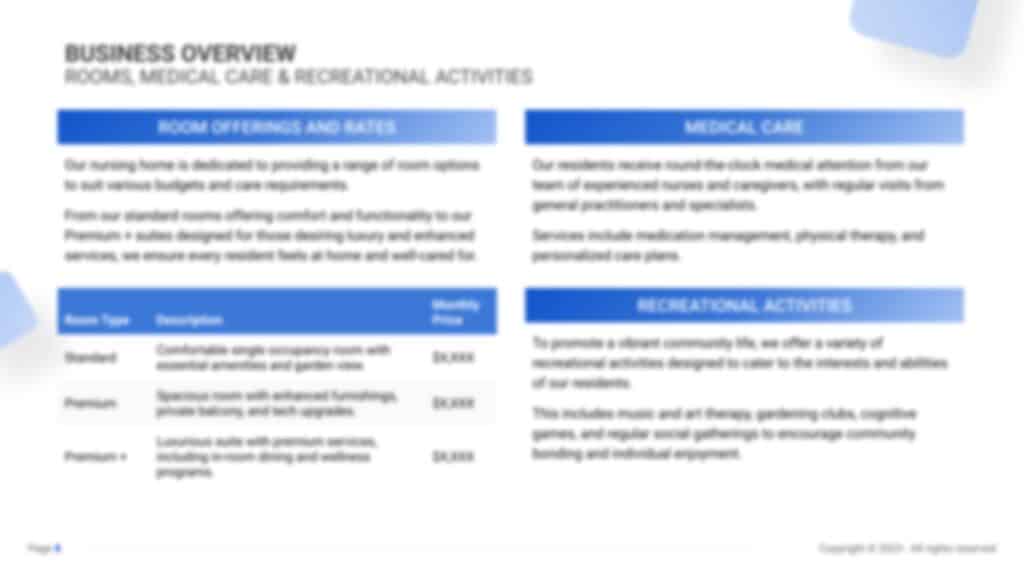
Market Overview

Industry size & growth
In the Market Overview of your nursing home business plan, start by examining the size of the elder care industry and its growth potential. This analysis is crucial for understanding the market’s scope and identifying expansion opportunities.
Key trends
Proceed to discuss recent market trends, such as the increasing consumer interest in personalized elder care services, wellness programs, and the integration of technology in resident care. For example, highlight the demand for services that cater to specific health needs and preferences, alongside the rising popularity of facilities that offer a more homelike environment.
Competitive Landscape
A competitive analysis is not just a tool for gauging the position of your nursing home in the market and its key competitors; it’s also a fundamental component of your business plan.
This analysis helps identify your nursing home’s unique selling points, essential for differentiating your business in a competitive market.
In addition, competitive analysis is integral in laying a solid foundation for your business plan. By examining various operational aspects of your competitors, you gain valuable information that ensures your business plan is robust, informed, and tailored to succeed in the current market environment.
Identifying Competitors in the Nursing Home Industry
The process of identifying competitors within the nursing home industry extends beyond merely recognizing local nursing homes and assisted living facilities. While these are primary competitors, it’s crucial to widen the scope to include indirect competitors. This encompasses in-home care services, retirement communities, adult day care centers, and even hospitals with specialized senior care units or transitional care wings.
Utilizing online resources tailored to healthcare facilities plays a pivotal role in comprehending the breadth and depth of services offered by competitors. Platforms such as Medicare’s Nursing Home Compare, state health department reports, and industry-specific databases offer comprehensive insights into quality ratings, staffing levels, regulatory compliance, and other crucial factors shaping the competitive landscape. A detailed analysis of these reports helps in understanding trends and benchmarking against competitors.

Nursing Home Competitors’ Strategies
A comprehensive analysis involves a multifaceted approach that delves into several critical aspects:
- Service Offerings: Evaluate the types of services offered and the extent of specialization within each service. For instance, a nursing home specializing in memory care might attract a different demographic than one focusing on post-acute rehabilitation or palliative care services.
- Quality of Care: Scrutinize patient reviews, accreditation status, and healthcare quality indicators. Facilities with high patient satisfaction ratings and superior care metrics often set the standard or present a competitive challenge.
- Staffing and Expertise: Consider the qualifications, experience, and specialization of staff members. A facility boasting specialized medical staff, ongoing training programs, or innovative care models may gain a competitive advantage.
- Pricing and Payment Options: Compare pricing structures and payment models. Some nursing homes prioritize affordability with flexible payment plans, while others position themselves as high-end luxury options with premium services.
- Marketing Strategies: Analyze competitors’ marketing tactics. This includes examining digital marketing efforts, community outreach programs, partnerships with healthcare providers, and referral networks utilized to attract prospective residents.
- Facility Infrastructure: Assess the physical environment and amenities offered. Modern, well-equipped facilities with innovative technology and enhanced living spaces often give nursing homes a competitive edge over older, more traditional facilities.
What’s Your Nursing Home’s Value Proposition?
Identify the unique selling points of your nursing home. It could be specialized care programs, a focus on holistic wellness, or a strong emphasis on personalized attention and family involvement.
Consider market gaps by analyzing patient feedback and industry trends. For instance, the rising demand for technologically integrated care solutions or culturally diverse care environments could present opportunities for innovation and differentiation.
Tailoring Services to Your Demographic and Location: Adapt your services to meet the specific needs of your demographic and location. A nursing home in an urban setting might emphasize convenient access to medical facilities, while one in a rural area might focus on fostering a tight-knit community environment.
Strategy
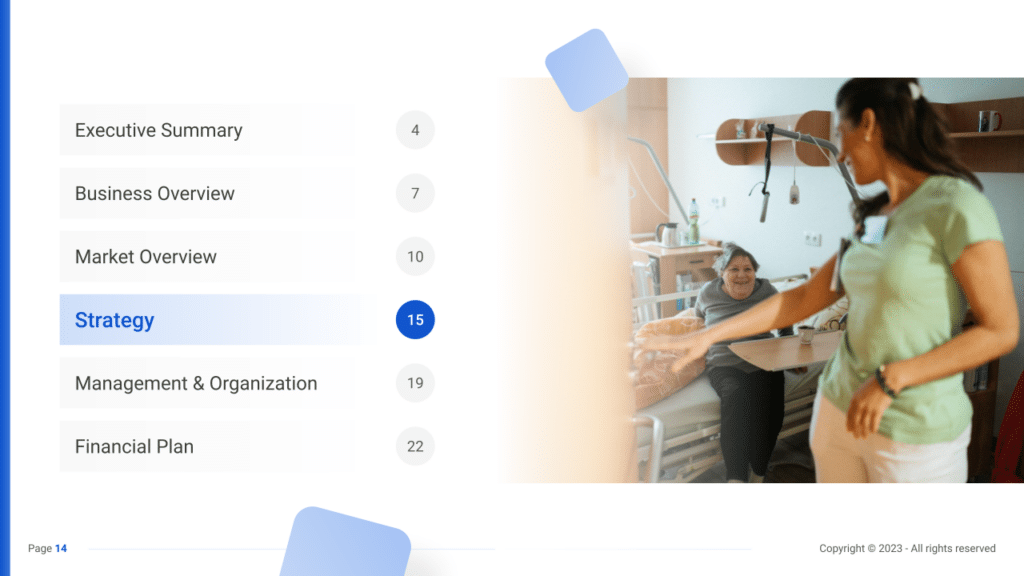
SWOT
First, conduct a SWOT analysis for the nursing home, highlighting Strengths (such as comprehensive care services and dedicated healthcare staff), Weaknesses (including potential regulatory challenges or the high costs of specialized care equipment), Opportunities (for example, an aging population increasing demand for elder care services), and Threats (such as changes in healthcare policies that may affect funding or operational costs).
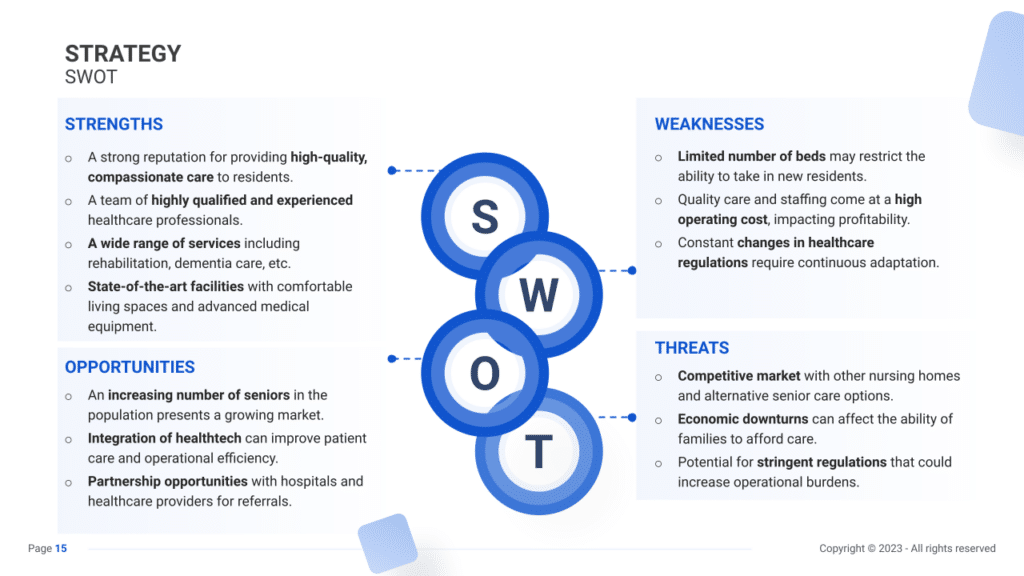
Marketing Plan
Next, develop a marketing strategy that outlines how to attract residents and reassure their families through targeted advertising, informational open houses, a reassuring and professional web presence, and community involvement to build trust and recognition.
Marketing Channels
Utilize various marketing channels to increase awareness and attract potential residents and their families.
Digital Marketing
Leveraging online platforms effectively:
- Utilize Social Media: Utilize social media platforms like Facebook, LinkedIn, and Twitter not only for promotions but also for sharing resident success stories, health tips, and insights into daily life at the nursing home.
- Email Marketing: Develop engaging email newsletters featuring healthcare articles, upcoming events, resident success stories, and updates on the facility’s services and improvements.
- Website Development: Develop a website with intuitive navigation, providing comprehensive information about the facility, care services, staff profiles, testimonials, and blog content focusing on healthcare advice, wellness tips, and community engagement.
Local Promotion and Community Engagement
Participating actively in the local community:
- Regular Community Newsletter: Produce a community-focused newsletter highlighting events, resident stories, and healthcare tips. Distribute this newsletter to community centers, libraries, and local businesses to enhance visibility and engagement.
- Participate in Community Events: Host or participate in health fairs, senior expos, and workshops on relevant health topics. Offer talks and seminars addressing common concerns of the elderly community.
- Collaborate with Health Professionals: Forge strong partnerships with local healthcare providers, hospitals, clinics, or physicians for mutual referrals and collaborative care programs.
Promotional Strategies
Implementing strategies to entice potential residents:
- Offer Trial Stays: Provide short-term stay options for potential residents to experience the nursing home firsthand, interact with staff, and understand the care environment.
- Referral Programs: Offer discounts, additional services, or referral bonuses to current residents or their families who refer new residents to your nursing home.

Sales Channels
Implement effective sales strategies to ensure a smooth admission process and enhance resident satisfaction.
Admissions Process
Facilitating smooth admissions:
- Streamlined Admission: Simplify the admission process with clear documentation, providing supportive staff assistance and guidance throughout the admission journey.
- Personalized Tours: Offer tailored tours to prospective residents and their families, showcasing the facilities, accommodations, recreational areas, and personalized care options available.
Continual Improvement
Continuously refining and adapting sales and marketing strategies:
- Regular Review: Continuously evaluate the effectiveness of sales and marketing approaches, ensuring alignment with the evolving needs and expectations of potential residents and their families.
- Feedback Integration: Encourage and welcome feedback from residents, their families, and staff to refine and improve approaches, ensuring sustained enhancements in service delivery and communication strategies.
Collaboration with Health Professionals
Building relationships for referrals:
- Referral Programs: Establish referral programs with local hospitals, healthcare practitioners, and home healthcare agencies. Incentivize referrals by offering mutual benefits or exclusive services.
- Collaborative Care Programs: Form collaborative care programs with healthcare providers, offering comprehensive healthcare solutions that benefit residents. These programs ensure seamless transitions between care settings and facilitate coordinated care.
Strategy Timeline
Finally, create a detailed timeline that outlines critical milestones for the nursing home’s opening, marketing efforts, resident recruitment, staff training, and quality assurance measures, ensuring the business moves forward with clear direction and purpose.

Management
The Management section focuses on the nursing home’s management and their direct roles in daily operations and strategic direction. This part is crucial for understanding who is responsible for making key decisions and driving the nursing home towards its financial and operational goals.
For your nursing home business plan, list the core team members, their specific responsibilities, and how their expertise supports the nursing home’s mission.


Financial Plan
The Financial Plan section is a comprehensive analysis of the nursing home’s financial strategy, including projections for revenue, expenses, and profitability. It lays out the nursing home’s approach to securing funding, managing cash flow, and achieving breakeven.
This section typically includes detailed forecasts for the first 5 years of operation, highlighting expected revenue, operating costs, and capital expenditures.
For your nursing home business plan, provide a snapshot of your financial statement (profit and loss, balance sheet, cash flow statement), as well as your key assumptions (e.g. pricing strategies for memberships and services, etc.).
Make sure to cover here
_ Profit and Loss
_ Cash Flow Statement
_ Balance Sheet
_ Use of Funds
